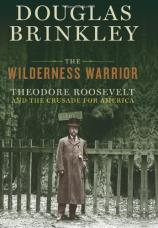The Wilderness Warrior: Theodore Roosevelt and the Crusade for America
Review
The Wilderness Warrior: Theodore Roosevelt and the Crusade for America
Fresh from his triumph with THE GREAT DELUGE, a brilliant
account of Hurricane Katrina, Douglas Brinkley has now tackled a
human hurricane --- Theodore Roosevelt, that rampant bundle of
energy and enthusiasm who served as U.S. President just over a
century ago.
His new book, however, is not a conventional biography. It
concentrates exclusively on Roosevelt’s consuming interest in
conservation --- the preservation of America’s wilderness
areas, protection of its endangered species of wildfowl, fish and
birds, and the consequent relentless warfare against anyone
Roosevelt felt was destroying such things simply for profit or
personal pleasure. To Brinkley, everything else about his
presidency (1901-1908) is distant background noise. His record of
trust-busting, his sponsorship of the Panama Canal project, his
post-Presidential career (including the Bull Moose campaign of
1912) are all preempted by his avid interest in bears, bison, rare
flowers and even reptiles. His colorful service in the
Spanish-American War, which made him a national hero and catapulted
him into Presidential politics, occupies only 20 of
Brinkley’s 817 pages, and even those few pages are studded
with Roosevelt’s observations on the flora and fauna of
Cuba.
Roosevelt himself emerges from this book as a kind of wild
animal himself, charging about the American west, snorting
disdainfully at his critics, uninterested in compromise, brushing
aside obstacles, going after what he wants with a kind of ferocious
joy. Brinkley concludes that Roosevelt actively enjoyed making his
enemies suffer.
Brinkley also confronts a widely-noted central paradox about his
subject, a man who strove mightily to preserve and protect wild
animals, yet also hugely enjoyed shooting them. Brinkley’s
take on this is that Roosevelt shot animals mainly for scientific
purposes and to donate specimens to museums. Yet he admits too that
Roosevelt thrilled in the act of the chase itself and seemed to
have a “blood lust.” Roosevelt even developed a
concept of the “fair chase,” which meant hunting
animals in a sportsmanlike way, without using unfair tactics that
robbed a potential victim of his chance of survival. But the end
result was usually another trophy skin or stuffed head for
Roosevelt, try as he might to cloak his pursuit in the mantle of
scientific research.
Brinkley also puts great emphasis on Roosevelt’s devotion
to Charles Darwin, whose theory of evolution he adopted as gospel
early on. He was always inspecting fish and animals to show how
they illustrated the truth of Darwin’s theory. He struck up
firm and lasting friendships with scientists like John Burroughs
and John Muir, who agreed with him and cheered him on, but he also
felt truly at home with rough-and-ready backwoodsmen who flattered
him by treating him as their equal. Brinkley conjures up a small
army of little-known wilderness gurus whose advice and admiration
Roosevelt cherished. An eastern aristocrat himself, he had nothing
but contempt for effete easterners who did not understand his
passion for nature.
Roosevelt spent early years as a rancher in the South Dakota
Badlands and as President made several triumphal tours of the west,
marveling at its scenic grandeur and dutifully cataloguing its many
species of rare animals. Brinkley enjoys citing Roosevelt’s
great concern for the rights of “citizen bird.”
Roosevelt had no patience with opponents who denounced his
activist view of government as “socialism” (yes, they
were saying that a century ago, too) and kept on creating new
national parks and protected wilderness areas until virtually the
last day of his Presidency, and enjoying the outraged howls of
miners and oilmen. He wrote something like 150,000 letters, over 30
books and a steady stream of magazine articles promoting wise land
use, protection of endangered species and soil conservation.
Brinkley has plowed the acreage of Roosevelt’s passion for
the west with incredible thoroughness. His prose sometimes comes
close to the kind of exuberant exclamatory hooroaring that marked
Roosevelt’s own speech. While earnest to a fault, it can
often get bogged down in detail, like some great powerful bird
stuck in a thicket.
The level of detail in this book is really daunting. You will
learn more --- if you care to --- about species of American bears
and the migratory habits of American birds than seems strictly
necessary. And before starting to read, you might acquaint yourself
with words like philotherian, frugivorous, epiphytic, laccolith and
xeric. Such rare species are seldom sighted even by
word-watchers.
Reviewed by Robert Finn (Robertfinn@aol.com) on January 24, 2011
The Wilderness Warrior: Theodore Roosevelt and the Crusade for America
- Publication Date: July 28, 2009
- Genres: History, Nonfiction
- Hardcover: 960 pages
- Publisher: Harper
- ISBN-10: 0060565284
- ISBN-13: 9780060565282





